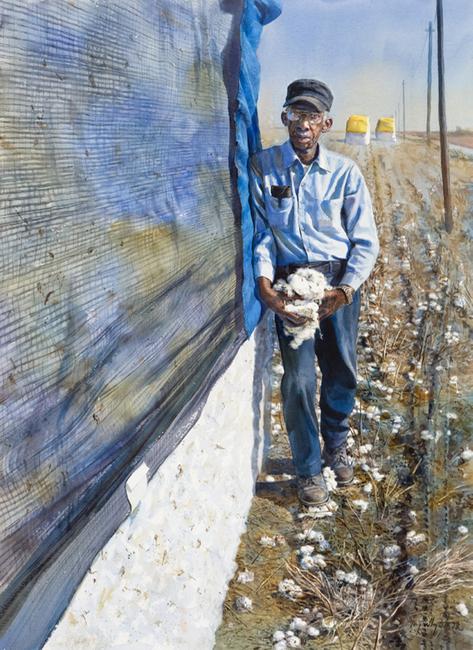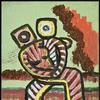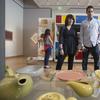Southern Workers Theme of Greenville (SC) Exhibition
- GREENVILLE, South Carolina
- /
- February 10, 2011


Watercolors tell the poignant stories of people whose jobs are fading away in the exhibition Mary Whyte: Working South, which opens to the public on March 9, 2011, at the Greenville County Museum of Art.
Working South brings together fifty watercolors, the product of a 3½-year project by Charleston artist Mary Whyte. The theme began to develop in 2007 when she was working on a commissioned portrait of a Greenville banker. While he was posing for sketches, Whyte commented on a newspaper headline about the closing of a textile mill. “In ten years,” said her subject, “all of those jobs may be gone.”
That conversation inspired a journey through ten Southern states, as Whyte researched and interviewed subjects, developing the studies that would culminate in paintings of hard-working Americans in professions that often fall under the radar. These are intimate portraits of workers left behind when jobs are outsourced or shipped offshore, people who are more related to the “old economy” than the new. They are cotton pickers and textile mill workers, wooden boat builders, crabbers and shrimpers, and tobacco farmers, among many others.
Mary Whyte met Annie Lindsay at the Springfield Mill in Gaffney, South Carolina. The artist asked the woman to post for photographs of her at work for the painting that would become Spinner. In Bishopville, Whyte was working on sketches at a diner when she met an itinerant crew of industrial cleaners. They are presented in the monumentally scaled Fifteen Minute Break. “They looked like chimney sweeps,” said the artist. “The only clean place on them was where they wore their goggles.”
Whyte found her subjects one by one with suggestions from family, friends, and people she met along the way. She wasn’t always welcomed, as she explained in a book she published to accompany the exhibition: “A few company executives bristled at my request to paint a ‘vanishing’ industry.’ I was shown the door more than once.”
“I had a pretty good idea of where I was going with my list, and what kind of person I would meet. I kept working my way south until I found what I was looking for, or until it found me. Any pre-conceptions I had would almost always prove to be wrong. I was continually astonished by the people I met, not only by their differences but by the things they had in common.”
Upstate South Carolina plays a central role in the exhibition. Not only did Whyte find several of her subjects here, but she also spent portions of two summers painting in a cottage in rural Simpsonville. Owned by Doug and Billie Hogg, the cottage became Whyte’s home and studio as she escaped the summer bustle of Charleston. She worked nearly twelve hours a day, taking a break at noon to share a farm-style meal with the Hoggs, who tended bees and grew vegetables that Whyte found almost unimaginable. One of their daughters, Jane Bechdoldt, is featured in the painting BeeKeeper’s Daughter.
“There are hundreds of people I could have painted,” wrote the artist. “Some of my choices were simply subjective. Most often, I looked for a profound quality, a humanness, that is easily recognized and can translate into the simplest of paintings.”
Born in Ohio in 1953, Mary Whyte graduated from the Tyler School of Art in Philadelphia with a degree in fine arts and a teaching certificate. She has earned national recognition in both watercolor and oil painting, but she is recognized principally for her figurative watercolors. Whyte’s portraits can be found in corporate, university, and private collections, and in museums that include the Greenville County Museum of Art.
Whyte is also an avid teacher who conducts painting workshops at locations around the country, including an annual session at the Greenville Museum. She has written instructional books and articles, including Watercolor for the Serious Beginner, 1995, and An Artist’s Way of Seeing, 2005.
Mary Whyte: Working South will be on view at the Greenville County Museum of Art through September 18, 2011, after which it travels to the Morris Museum of Art in Augusta, Georgia (December 1, 2011–March 11, 2019); the Gibbes Museum of Art in Charleston, South Carolina (May 4–September 9, 2012); the Telfair Museums’ Telfair Academy in Savannah, Georgia (October 5, 2012–February 24, 2013); and the Peninsula Fine Arts Center in Newport News, Virginia (April 6–July 7, 2013).
There are several programs related to the exhibition in the museum’s Sundays@2 series. All take place on Sundays at 2:00 pm, and all are free and open to the public. On March 13, Whyte will give an illustrated lecture on the exhibition. A book signing with the artist will follow. A docent-led tour of Working South takes place on April 17 and June 19; and members of the Emrys literary foundation will offer poetic interpretations of the art on May 1. A Working South Family Adventure takes place on July 17, 2011.
The exhibition is sponsored by Carolina First. Carolina First Bank is a trade name of TD Bank, N.A.
The Greenville County Museum of Art is located at 420 College Street, on Heritage Green in downtown Greenville, South Carolina. The Museum is open Tuesday–Saturday 11–5 and Sunday 1–5. Galleries are closed on Mondays and major holidays. Admission is always absolutely free.
Contact:
Mary McCarthyGreenville County Museum of Art
864-271-7570, ext 28
marymc@greenvillemuseum.org
420 College Street
Greenville, South Carolina
info@greenvillemuseum.org
864-271-7570
http://greenvillemuseum.org
About Greenville County Museum of Art
The Greenville County Museum of Art is counted among the country's premier American art museums, drawing visitors from around the world to see installations of work by two of the nation's greatest contemporary artists, Andrew Wyeth and Jasper Johns. Watch the Museum's website for a full schedule of exhibitions and special events. Open Tuesday-Saturday, 11am-5pm, Sundays 1pm-5pm. Closed Mondays and major holidays. Admission is always absolutely free.















